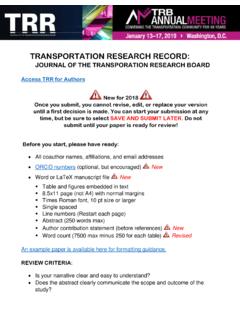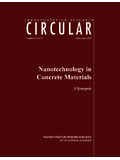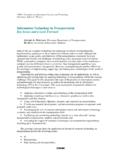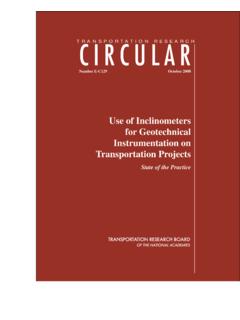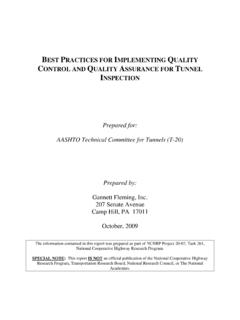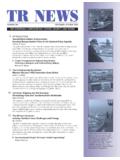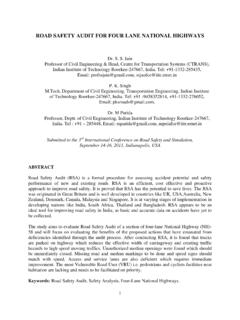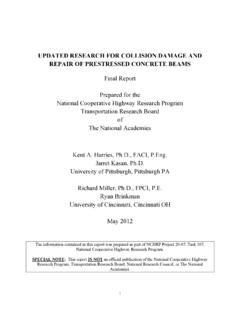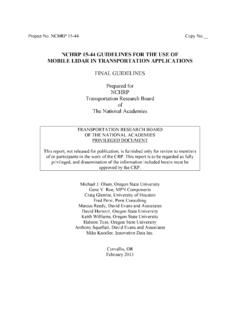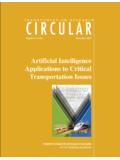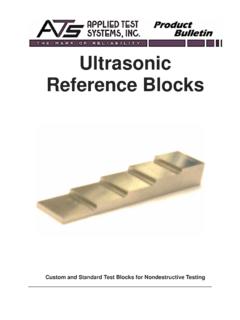Transcription of RAPID CONCRETE BRIDGE PROTECTION, REPAIR AND …
1 SHRP-S-344. CONCRETE BRIDGE protection and Rehabilitation: Chemical and Physical Techniques RAPID CONCRETE BRIDGE Deck protection , REPAIR and Rehabilitation Michael M. Sprinkel Angela R. Sellars Virginia Transportation research Council Charlottesville, Virginia Richard E. Weyers Virginia Polytechnic Institute and State University Blacksburg, Virginia strategic highway research Program National research Council Washington, DC 1993. SHRP-S-344. Contract C-103. ISBN 0-309-05604-7. Product Code 2035. Program Man_tger: Don M. Harriott Project Manager: Joseph F. Lamond Program Area Secretary: Carina S. Hreib Copyeditor: Katharyn L. Bine Brosseau August 1993. key words: BRIDGE mainter, ance portland cement CONCRETE chlorides CONCRETE remo_,al corrosion maintenance patching polymer overhqs sealers strategic highway research Program 2101 Constitution Avenue Washington, DC 20418. (202) 334-3774. The publication of this report does not necessarily indicate approval or endorsement by the N, tional Academy of Sciences, the United States Government, or the American Association of State highway and Transportation Officials or its member states of the findings, opinions, conclusions, or recommendations either inferred or specifically expressed herein.
2 1993 Nationat Academy of Sciences Acknowledgments The research described herein was supported by the strategic highway research Program (SHRP). SHRP is a unit of the National research Council that was authorized by section 128. of the Surface Transportation and Uniform Relocation Assistance Act of 1987. The State Department of Transportation BRIDGE , materials, and maintenance engineers, and the SHRP state coordinators assisted us by providing responses to the questionnaire and other information in this document. In particular, personnel in the states of California, Indiana, Michigan, Nebraska, Ohio, Virginia, and Washington assisted us with the evaluations fo selected BRIDGE decks that provided for the collection of the most significant data contained in this report. Also, the Federal highway Administration provided funding for the earlier evaluations of most of the decks for which background data were available.
3 111. Contents Acl_aow!edgments .. iii List of Figures .. vii List of Tables .. ix Abstract .. 1. Executive Summary .. 3. 1 Introduction .. 5. Criteria for RAPID BRIDGE Deck Treatment Methods 5. research Approach 8. Literature Review and Questionnaire Response 8. Field Evaluations 9. Final Report and Field Manual 9. RAPID protection , REPAIR , and Rehabilitation Treatments 10. Treatments Identified 10. Polymer Overlays 12. Sealers 14. High-Early-Strength Hydraulic Cement CONCRETE Overlays 16. Patches 18. Other Treatment Methods 22. Minimum Curing Time 24. 2 Performance of protection , REPAIR , and Rehabilitation Treatments .. 27. Introduction 27. Permeability to Chloride Ion 30. RAPID Test on Cores 30. Chloride Content of Field Samples 41. Corrosion of Reinforcing Bars 44. Half-Cell Potentials 44. Rate of Corrosion 45. Skid Resistance and Wear 48. Polymer Overlays 48. Sealers 54. V. Patching Materials 54.
4 Bond Strength 54. Tensile Bond Strength 54. Shear Bond Strength 56. Cracks, Delaminations, and Spalts 56. Polymer Overlays and Sealers 56. Patches 56. 3 Service I,ife of RAPID Deck protection , REPAIR and Rehabilitation Treal,ments .. 61. !Literature Review and Questionnaire Response 61. ;Field Evaluations 61. Effect of Treatment on Service ]Lifeof BRIDGE Deck 67. 4 Observations .. 69. 5 Conclusions .. 71. 6 Recommendations .. 73. Appendix A: Outline of RAPID Treatments for BRIDGE Deck protection , REPAIR , and Rehabilitation .. 75. Appendix B: Summary of Data from Field Evaluations .. 79. References .. 103. vi List of Figures Flow diagram for RAPID BRIDGE deck treatment methods .. 6. RAPID CONCRETE barrier placement and removal system .. 7. An epoxy-urethane binder is spread over a shotblasted surface with notched squeegees. Basalt aggregate is broadcast to excess to provide one layer of a multiple-layer polymer overlay.
5 13. A high-molecular-weight methacrylate sealer is applied to tined surfaces .. 15. A high-early-strength latex-modified portland cement CONCRETE overlay is placed on a scarified and shotblasted deck surface .. 17. A prepackaged RAPID -hardening hydraulic cement CONCRETE material is used for partial depth patching on a BRIDGE deck .. 20. Special blended cement ready-mix CONCRETE is used to replace a segment of the top half of a BRIDGE deck during an 8-hour lane closure .. 21. Approximate locations of samples and measurements at each of the five sites on decks with polymer overlays .. 31. Permeability to chloride ion (AASHTO T 277) for cores taken from decks with polymer overlays and sealers in 1991 .. 33. Permeability to chloride ion (AASHTO T 277) versus age for cores from decks treated with epoxy sealers .. 35. Permeability to chloride ion (AASHTO T 277) versus age for cores from decks treated with a high-molecular- weight methacrylate sealer and a silane sealer.
6 36. Permeability to chloride ion (AASHTO T 277) for cores taken from patches in 1991 .. 37. vii Permeability to chloride ion (AASHTO T 277) versus age for cores from decks with polymer overlays and sealers .. 38. Perrrteability to chloride ion (AASHTO T 277) for cores taken from as compared to those taken from travel lanes for silane-treated decks .. 39. Permeability to chloride ion (AASHTO T 277) versus age and cumalative traffic for cores from decks with multiple-layer polymer overlays .. 40. Permeability to chloride ion (AASHTO T 277) versus age for cores from decks with multiple-layer polymenr overlays with three ADTs and thre_ salt .. 42. Average annual change in chloride ion content .. 43. Relationship between half-cell potential measurements and chloride ion contents at the reinforcing bars for _:tntreated decks with and withoJt patches and decks with multiple-layer epoxy overlays .. 46.
7 Rate of corrosion versus chloride ion content at the reinforcing bais .. 47. Half-call potential, rate of corrosion:, and chloride ion content at tee reinforcing bars as a function of distance from a patch .. 49. Average chloride contents at the reinforcing bars and rates of corrosion for patched decks .. 50. Bald tire skid number (ASTM E 524) versus age for polymer overlays .. 51. Bald tire skid number versus cumulative traffic for multiple-layer polymer overlays .. 52. Bald tire skid number versus age for decks with polymer overlays sealers .. 53. Tensile rupture strength (ACI 503R,. VTM 92) versus age for polymer overlays .. 55. Ten:_ile rupture strength (ACI 503R, VTM 92) versus cumulative t:'affic and salt application for polymer overlays .. 57. Ten:;ile rupture strength (ACI 503R, VTM 92) versus age for muir pie-layer epo_,'yoverlays constructed with aggregates having different gradations.
8 58. Length change of typical RAPID -hardening patching concretes allowed to air cure in the laboratory at 72 F (22 C) and 50 percent relative humidity .. 59..oo Vlll List of Tables Table Frequency of use of RAPID BRIDGE deck treatment methods .. 11. Table Minimum curing times for RAPID protection treatments, hours .. 25. Table Field evaluations .. 28. Table Years of service life of protection treatments based on questionnaire response and literature review .. 63. Table Years of service life of RAPID protection treatments based on field evaluations .. 65. Table B1 General information on BRIDGE decks evaluated .. 80. Table B2 General information on protection and patching treatments evaluated .. 82. Table B3 Permeability to chloride ion test results (AASHTO T 277) .. 84. Table B4 Average chloride content test results .. 88. Table B5 Electrical half-cell potential test results .. 90. Table B6 Rate of corrosion test results, 1991.
9 96. Table B7 Skid number at 40 mph .. 97. Table B8 Tension adhesion test results .. 99. Table B9 Average guillotine shear rupture strength test results .. 101. Table B10 Deck assessment data, 1991 .. 102. ix Abstract This report presents the RAPID methods used by state highway agencies for the protection , REPAIR and rehabilitation of BRIDGE decks. The report is based on a review of the literature; the responses to questionnaires sent to state Departments of Transportation, Canadian provinces, selected turnpike and thruway authorities, technology transfer centers, and material suppliers; and the evaluation of 50 BRIDGE decks located in seven states. Polymer overlays, sealers, high-early-strength hydraulic cement CONCRETE overlays, and patches are compared for their performance characteristics and service life. Executive Summary This report presents the RAPID treatment methods being used by state highway agencies for the protection , REPAIR and rehabilitation of BRIDGE decks.
10 The report is based on a review of the literature; the responses to questionnaires sent to state Departments of Transportation, Canadian provinces, selected turnpike and thruway authorities, technology transfer centers, and material suppliers; and the evaluation of 50 BRIDGE decks located in seven states. RAPID treatment methods can be installed during off-peak traffic periods and are suitable for traffic during peak traffic periods. Lane closure, CONCRETE removal, surface preparation, and installation and curing of materials are all done during off-peak traffic periods. Typical off-peak lane closure periods for RAPID methods are < 8 hr, < 12 hr, <. 21 hr, and < 56 hr. Bridges that are candidates for RAPID treatment methods have peak-hour traffic volumes that are so high that it is not practical to close a lane to treat the deck except during off-peak traffic periods. RAPID protection methods restrict the infiltration of chloride ions into CONCRETE that is not critically contaminated with chloride (chloride ion content exclusive of background chloride is < lb/yd 3 [ kg/m 3] and half-cell potentials are > -250 mV.)
